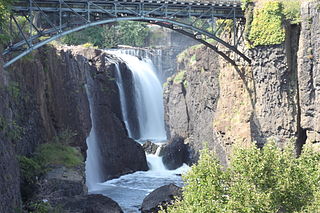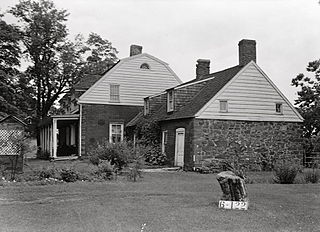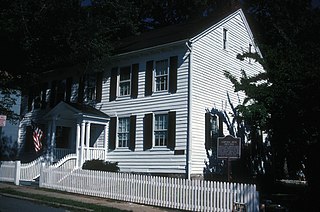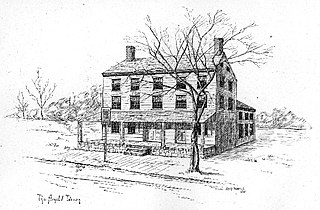
Passaic County is a county in the U.S. state of New Jersey that is part of the New York metropolitan area. As of the 2020 United States census, the county was the state's eighth-most-populous county, with a population of 524,118, its highest decennial count ever and an increase of 22,892 (+4.6%) from the 2010 census count of 501,226, which in turn reflected an increase of 12,177 (+2.5%) from the 489,049 counted in the 2000 census.

Wayne is a township in Passaic County, in the U.S. state of New Jersey. Home to William Paterson University and located less than 20 miles (32 km) from Midtown Manhattan, the township is a bedroom suburb of New York City and regional commercial hub of North Jersey. As of the 2020 United States census, the township's population was 54,838, an increase of 121 (+0.2%) from the 2010 census count of 54,717, which in turn reflected an increase of 648 (+1.2%) from the 54,069 counted in the 2000 census.

Richard Varick was an American lawyer, military officer, and politician who has been referred to as "The Forgotten Founding Father." A major figure in the development of post-Independence New York City and the state of New York, Varick became the 45th Mayor of New York City in 1789 and served eleven consecutive one-year terms until 1801.

Morristown National Historical Park is a United States National Historical Park, headquartered in Morristown, New Jersey, consisting of four sites important during the American Revolutionary War: Jockey Hollow, Ford Mansion, Fort Nonsense, and Washington's Headquarters Museum.
Packanack Lake is an unincorporated lake community and census-designated place (CDP) in Wayne in Passaic County, in the U.S. state of New Jersey. The community is located 30 minutes northwest of Manhattan.

Buccleuch Mansion is located in Buccleuch Park in New Brunswick in Middlesex County, New Jersey, along the Raritan River.

New Bridge was a prosperous mill hamlet, centered upon a bridge strategically placed at the narrows of the Hackensack River. In the American Revolution, New Bridge Landing was the site of a strategic bridge crossing the Hackensack River, where General George Washington led his troops in retreat from British forces November 20, 1776. Eleven engagements took place here throughout the war. The current Draw Bridge at New Bridge was installed in 1889 and added to the National Register of Historic Places on July 5, 1989. The area is now a New Jersey historic site in portions of New Milford, River Edge, Hackensack and Teaneck in Bergen County, New Jersey.

The Steuben House is a noted example of Bergen Dutch sandstone architecture, located at New Bridge Landing on the Hackensack River in River Edge, in Bergen County, New Jersey, United States.

The Ford Mansion, also known as Washington's Headquarters, is a classic 18th-century American home located at 30 Washington Place in Morristown, New Jersey that served as General George Washington's headquarters from December 1779 to June 1780 during the American Revolutionary War.
The Wayne Public Schools are a comprehensive community public school district that serves students in pre-kindergarten through twelfth grade from Wayne, in Passaic County, in the U.S. state of New Jersey, in the New York City metropolitan area.

New Barbadoes Neck is the name given in the colonial era for the peninsula in northeastern New Jersey, US between the lower Hackensack and Passaic Rivers, in what is now western Hudson County and southern Bergen County. The neck begins in the south at Kearny Point in the Newark Bay and is characterized by a ridge along the west and part of the New Jersey Meadowlands on the east.

The Schuyler–Colfax House is located at 2343 Paterson Hamburg Turnpike in Wayne, Passaic County, New Jersey, United States. The house was built in 1695 by Arent Schuyler. It was documented by the Historic American Buildings Survey in 1936. The house was added to the National Register of Historic Places on April 3, 1973, for its significance in architecture.

Van Riper–Hopper House is located in Wayne, Passaic County, New Jersey, United States. The house was built in 1786 and was added to the National Register of Historic Places on August 21, 1972. The house is home to the Wayne Township Museum.

Westside Park is a 26.6-acre (10.8 ha) municipal park located between the Passaic River and Totowa Avenue in the city of Paterson in Passaic County, New Jersey, United States. It is home to the historic Van Houten House, which was built in 1831 and was documented by the Historic American Buildings Survey (HABS) in 1936. The two-story brick house was added to the National Register of Historic Places on March 7, 1973, for its significance in architecture and urban planning.
Fred Wesley Wentworth was an American architect known for his extensive contributions to the architectural landscape of Downtown Paterson, New Jersey, as well as various residences and theaters across northeastern New Jersey. Wentworth played a pivotal role in reshaping Paterson following a devastating wind-driven fire that destroyed much of the city's central business district in 1902. His architectural portfolio encompassed a diverse range of building types, including institutional, commercial, residential, religious, and healthcare structures, as well as some of the nation's earliest movie theaters designed exclusively for motion pictures. He was recognized as a Fellow of the American Institute of Architects.
Preakness Valley Park and Golf Course is located in Wayne Township and Totowa Borough, New Jersey, United States, along Totowa Road and Riverview Drive. Of the total 377 acres in the park, 298 acres are located in Wayne and 79 are located in Totowa. The park contains a public 36 hole golf course, split into 2 18-hole layouts. Made public in 1931, this full service course is considered the first public golf course in Passaic County. It has a clubhouse, caddy house, practice facilities, and on site maintenance facilities.

The Dr. Jabez Campfield House, also known as the Schuyler Hamilton House, is a historic, two-story, braced timber-frame colonial Georgian-style house and museum located at 5 Olyphant Place, Morristown, New Jersey.
William McAdam was a Scottish-American merchant and businessman who served as the president of the Saint Andrew's Society of the State of New York.

Jacob Arnold's Tavern, also known as the OldArnold Tavern and the Duncan House, was a "famous" historic tavern established by Samuel Arnold circa 1740. Until 1886, it was located in Morristown Green in Morristown, New Jersey. In 1777 it served as George Washington's headquarters during the Revolutionary War, and it was the site of Benedict Arnold's first trial in 1780. The National Park Service claims "Much of [Morris]town's social, political, and business life was conducted at Arnold's Tavern" during the Revolutionary era.


























